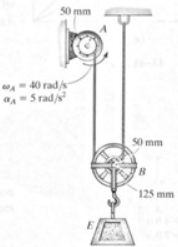A motor winds the pulley at A with the kinematic quantities given. Find the acceleration of block E at this instant. (Figure difficult? The radius of the wheel B to the fixed rope is 50 mm, while the radius of the wheel attached to A is 125 mm.) I believe the difficulty to this problem, to the degree it is difficult, is in recognizing what you have and putting it into a familiar form. Feel free to contact me to discuss it.
A motor winds the pulley at A with the kinematic quantities given. Find the acceleration of block E at this instant. (Figure difficult? The radius of the wheel B to the fixed rope is 50 mm, while the radius of the wheel attached to A is 125 mm.) I believe the difficulty to this problem, to the degree it is difficult, is in recognizing what you have and putting it into a familiar form. Feel free to contact me to discuss it.
Elements Of Electromagnetics
7th Edition
ISBN:9780190698614
Author:Sadiku, Matthew N. O.
Publisher:Sadiku, Matthew N. O.
ChapterMA: Math Assessment
Section: Chapter Questions
Problem 1.1MA
Related questions
Question

Transcribed Image Text:**Problem Description:**
1. A motor winds the pulley at \( A \) with the kinematic quantities given. Find the acceleration of block \( E \) at this instant.
(Is the figure difficult? The radius of the wheel \( B \) to the fixed rope is 50 mm, while the radius of the wheel attached to \( A \) is 125 mm.)
I believe the difficulty in this problem, to the degree it is difficult, is in recognizing what you have and putting it into a familiar form. Feel free to contact me to discuss it.
**Diagram Explanation:**
- The diagram features a pulley system.
- At the top center, there's a motor connected to a wheel at point \( A \), with angular velocity \((\omega_A = 40 \, \text{rad/s})\) and angular acceleration \((\alpha_A = 5 \, \text{rad/s}^2)\).
- The radius of the wheel at \( A \) is 125 mm.
- A smaller wheel \( B \) with a radius of 50 mm is below \( A \).
- A rope is attached to wheel \( B \), winding around the system, with one end attached to block \( E \).
- Block \( E \) hangs at the bottom of the rope.
This setup is commonly used to explore rotational dynamics and translational acceleration in physics and engineering problems.
Expert Solution
Step 1
Given:

To find:
Acceleration of block E
Step by step
Solved in 3 steps with 1 images

Knowledge Booster
Learn more about
Need a deep-dive on the concept behind this application? Look no further. Learn more about this topic, mechanical-engineering and related others by exploring similar questions and additional content below.Recommended textbooks for you

Elements Of Electromagnetics
Mechanical Engineering
ISBN:
9780190698614
Author:
Sadiku, Matthew N. O.
Publisher:
Oxford University Press

Mechanics of Materials (10th Edition)
Mechanical Engineering
ISBN:
9780134319650
Author:
Russell C. Hibbeler
Publisher:
PEARSON

Thermodynamics: An Engineering Approach
Mechanical Engineering
ISBN:
9781259822674
Author:
Yunus A. Cengel Dr., Michael A. Boles
Publisher:
McGraw-Hill Education

Elements Of Electromagnetics
Mechanical Engineering
ISBN:
9780190698614
Author:
Sadiku, Matthew N. O.
Publisher:
Oxford University Press

Mechanics of Materials (10th Edition)
Mechanical Engineering
ISBN:
9780134319650
Author:
Russell C. Hibbeler
Publisher:
PEARSON

Thermodynamics: An Engineering Approach
Mechanical Engineering
ISBN:
9781259822674
Author:
Yunus A. Cengel Dr., Michael A. Boles
Publisher:
McGraw-Hill Education

Control Systems Engineering
Mechanical Engineering
ISBN:
9781118170519
Author:
Norman S. Nise
Publisher:
WILEY

Mechanics of Materials (MindTap Course List)
Mechanical Engineering
ISBN:
9781337093347
Author:
Barry J. Goodno, James M. Gere
Publisher:
Cengage Learning

Engineering Mechanics: Statics
Mechanical Engineering
ISBN:
9781118807330
Author:
James L. Meriam, L. G. Kraige, J. N. Bolton
Publisher:
WILEY